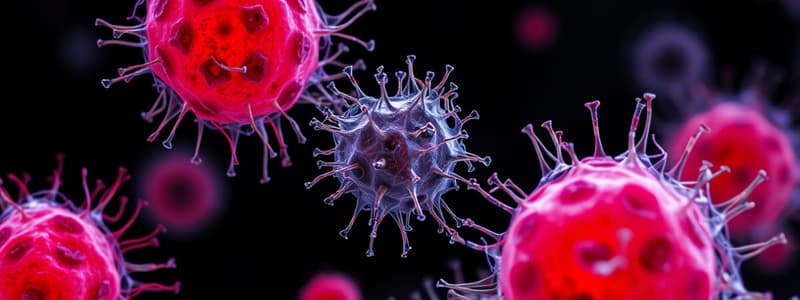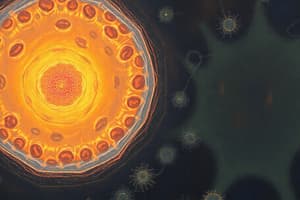Podcast
Questions and Answers
What is the primary function of carrier proteins in passive transport?
What is the primary function of carrier proteins in passive transport?
- To actively pump ions against their concentration gradient
- To utilize energy from ATP for substance movement
- To operate passively and aid in the movement of substances down a concentration gradient (correct)
- To enclose macromolecules within vesicles
Which process is characterized as the ingestion of particles, such as bacteria, by specialized cells?
Which process is characterized as the ingestion of particles, such as bacteria, by specialized cells?
- Endocytosis
- Receptor-mediated endocytosis
- Phagocytosis (correct)
- Pinocytosis
What type of transport involves the diffusion of water across a selectively permeable membrane?
What type of transport involves the diffusion of water across a selectively permeable membrane?
- Vesicular transport
- Simple diffusion
- Facilitated diffusion
- Osmosis (correct)
Which type of endocytosis is responsible for the uptake of extracellular fluid and its dissolved contents?
Which type of endocytosis is responsible for the uptake of extracellular fluid and its dissolved contents?
What is the role of ATP in active transport mechanisms?
What is the role of ATP in active transport mechanisms?
What distinguishes eukaryotic cells from prokaryotic cells?
What distinguishes eukaryotic cells from prokaryotic cells?
What is the primary role of the cell membrane?
What is the primary role of the cell membrane?
Which statement accurately describes embryonic stem cells?
Which statement accurately describes embryonic stem cells?
What happens to cells during differentiation?
What happens to cells during differentiation?
How do integral proteins differ from peripheral proteins?
How do integral proteins differ from peripheral proteins?
Which of the following correctly describes the structure of phospholipids?
Which of the following correctly describes the structure of phospholipids?
Which molecule primarily facilitates the passive transport of water across cell membranes?
Which molecule primarily facilitates the passive transport of water across cell membranes?
What role do glycolipids play in cellular structure?
What role do glycolipids play in cellular structure?
What is the function of integrins in the plasma membrane?
What is the function of integrins in the plasma membrane?
Flashcards are hidden until you start studying
Study Notes
Basic Unit of Life
- Cells are the fundamental and smallest living units of the body.
- Tissues are composed of cells, serving as both structural and functional units.
Types of Cells
- Prokaryotic Cells:
- Lack membrane-bound nuclei.
- Typically have a cell wall and are primarily bacterial.
- Eukaryotic Cells:
- Contain distinct membrane-limited nuclei.
- Commonly found in animals, surrounded by cytoplasm with organelles and cytoskeleton.
Zygote and Cellular Development
- Formation of a zygote occurs through the fusion of a spermatozoon and oocyte during fertilization.
- Zygotic divisions yield blastomeres, which develop into all fetal tissue types.
- Embryonic stem cells originate from the inner cell mass, cultured for differentiation.
Differentiation Process
- Cells undergo differentiation, a process where specific genes express to perform unique functions.
- Muscle cell precursors develop into elongated fibers containing actin and myosin.
- All animal cells are equipped with actin filaments and myosin.
Specialized Cells
- Differentiated cells increase their functional capabilities significantly.
- Environmental factors can influence variability in cell features and activities.
- Structurally similar cells can have different receptor families for signaling.
Cell Membrane Functions
- Acts as a selective barrier, regulating material movement in and out of the cell.
- Maintains constant ion composition in cytoplasm and facilitates specific molecule transport.
- Membrane proteins, like integrins, connect the cytoskeleton to the extracellular matrix (ECM).
Membrane Structure
- Membranes can only be seen under an electron microscope and vary in thickness.
- Phospholipids: Composed of nonpolar fatty acids and a polar head, they form bilayers for stability.
- Glycolipids: Present in the outer layer, contributing to the glycocalyx, a protective cell surface coating.
- Membranes are approximately 50% protein by weight, including integral and peripheral proteins.
Fluid Mosaic Model
- Membrane proteins can move laterally, demonstrating fluidity.
- The plasma membrane mediates exchanges between the cell and its environment.
Transport Mechanisms
- Diffusion: Small, nonpolar molecules move freely through lipid bilayers; lipophilic molecules diffuse easily, while water does so more slowly.
- Channels: Multimeric proteins create transmembrane pores for selective ion passage, regulated by physiological stimuli.
- Carriers: Transmembrane proteins that bind and move small molecules across the membrane.
Passive Transportation
- Passive transport includes diffusion, channels, and carrier proteins, allowing substances to move down concentration gradients.
- Types:
- Simple Diffusion: Direct movement across membrane.
- Facilitated Diffusion: Assisted by transport proteins.
- Osmosis: Water diffusion through a selectively permeable membrane.
Active Transport
- Active transport requires energy (ATP) to move ions and solutes against their gradients, commonly via ATPases.
Vesicular Transport
- Macromolecules enter cells through endocytosis, where the plasma membrane folds around them.
- Types of Endocytosis:
- Phagocytosis: Engulfing bacteria or dead cells, specialized cells like macrophages perform this function.
- Pinocytosis: Involves membrane invaginations that capture extracellular fluid and solutes.
- Receptor-mediated endocytosis: Specific to receptor-ligand interactions leading to internalization.
Key Notes on Phagocytosis
- Neutrophils encase bacteria in a phagosome, which then merges with lysosomes for degradation.
- Pinocytotic Vesicles: Formed from fluid entrapment, may fuse with lysosomes or transport contents elsewhere in the cell.
Studying That Suits You
Use AI to generate personalized quizzes and flashcards to suit your learning preferences.




